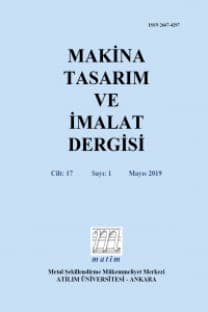Alüminyum Al6061-T6‘nın İşlenmesinde Sürtme Kuvvetinin Hesaplanması ve Sürtünme Katsayısının Etkisinin Araştırılması
Metal kesme işlemlerinde, takım kenar yarıçapının (edge radius) etkisiyle ortaya çıkan sürtme (ploughing) kuvveti takım aşınması, akış geriliminin tahmini, talaş oluşum mekanizması, yüzey kalitesi ve metal kesme işleminin sonlu elemanlar yöntemi ile modellenmesi açısından önemli bir değişkendir. Literatürde, sürtme (ploughing) kuvveti kararlı hale (steady state) gelmiş metal kesme işlemlerindeki periyodik kuvveti temel alarak tahmin edilebilmiştir. Fakat periyodik kuvvet çoğu metal kesme işlemlerinde ortaya çıkmamaktadır. Bu makalede, sürtme kuvveti kesilmemiş talaş kalınlığını (uncut chip thickness) ekstrapolasyon yöntemi ile sıfıra yakınsayarak tahmin edilmiştir. Sürtme (ploughing) kuvvetinin bu yöntem ile tahmin edilmesinden sonra Coulomb sürtünme katsayısı hesaplanılarak yapılan varsayımın doğru olup olmadığı karşılaştırılmıştır. Tahmin edilen sürtme (ploughing) kuvveti, kesilmemiş talaş kalınlığına karşı çizildiğinde daha homojendir ve Coulomb sürtünme değeri literatürde bulunan sürtünme kuvvetleriyle oldukça yakın çıkmıştır. Bu yüzden, periyodik kuvvetin oluşmadığı metal kesme işlemlerinde, sürtme (ploughing) kuvvetini ekstrapolasyon yöntemi ile tahmin etmek ve Coulomb sürtünme değerini hesaplamak kabul edilebilir görünmektedir.
Anahtar Kelimeler:
Alüminyum Al6061-T6, Talaşlı İmalat, Sürtme Kuvveti, Coulomb Sürtünme Katsayısı
INVESTIGATION OF THE CALCULATION PLOUGHING FORCE AND THE EFFECT OF FRICTION COEFFICIENT IN MACHINING OF ALUMINUM 6061-T6
In metal cutting operations, the ploughing force, which occurs due to the effect of edge radius of the tool that is an essential factor in terms of tool wear, prediction of flow stress, chip formation mechanism, surface quality and finite element modeling of metal cutting operations. In the literature, the ploughing force was estimated based on the periodic force in steady state metal cutting operations. However, periodic force does not occur in most metal cutting operations. In this article, the ploughing force was estimated by integrating uncut chip thickness to zero value by using extrapolation method. After estimating the ploughing force by this method, the Coulomb friction coefficient can be calculated and the precision of the assumption is compared. The estimated ploughing force is more homogeneous when plotted against uncut chip thickness, and the Coulomb friction coefficient is quite accurate to friction value which found in the literature. Hereby, the assumption is acceptable to estimate the ploughing force by using extrapolation method and the calculation of the Coulomb friction is valid in metal cutting operation which periodic force does not occur.
___
- 1. Y. Altintas and I. Yellowley, "In-process detection of tool failure in milling using cutting force models." 1989.
- 2. M. Elbestawi, T. Papazafiriou, and R. Du, "In-process monitoring of tool wear in milling using cutting force signature." International Journal of Machine Tools and Manufacture, 1991. 31(1): pp. 55-73.
- 3. J. Sutherland and R.E. Devor, "An improved method for cutting force and surface error prediction in flexible end milling systems." 1986.
- 4. Y. Altintas, D. Montgomery, and E. Budak, "Dynamic peripheral milling of flexible structures." 1992.
- 5. M.C. Shaw and J. Cookson, "Metal cutting principles. Vol. 2. 2005: Oxford university press New York.
- 6. M.E. Merchant, "Mechanics of the metal cutting process. I. Orthogonal cutting and a type 2 chip." Journal of applied physics, 1945. 16(5): pp. 267-275.
- 7. R. Stevenson, "Study on the correlation of workpiece mechanical properties from compression and cutting tests." Machining science and technology, 1997. 1(1): pp. 67-79.
- 8. Y. Guo, "An integral method to determine the mechanical behavior of materials in metal cutting." Journal of Materials Processing Technology, 2003. 142(1): pp. 72-81.
- 9. R. Stevenson, "The measurement of parasitic forces in orthogonal cutting." International journal of machine Tools and manufacture, 1998. 38(1-2): pp. 113-130.
- 10. H. Tönshoff, H.-G. Wobker, and D. Brandt, "Hard turning-influences on the workpiece properties." Transactions-North American Manufacturing Research Institution of Sme, 1995: pp. 215-220.
- 11. G. Boothroyd, "Fundamentals of metal machining and machine tools. Vol. 28. 1988: Crc Press.
- 12. P. Albrecht, "New developments in the theory of the metal-cutting process: part I. The ploughing process in metal cutting." Journal of engineering for industry, 1960. 82(4): pp. 348-357.
- 13. P. Wallace and G. Boothroyd, "Tool forces and tool-chip friction in orthogonal machining." Journal of Mechanical Engineering Science, 1964. 6(1): pp. 74-87.
- 14. T. HSU. "A study of normal and shear stresses on a cutting tool". in Mechanical Engineering. 1965. Asme-Amer Soc Mechanical Eng 345 E 47TH ST, New York, NY 10017.
- 15. J. Baiey, "Friction in metal machining mechanical spects." Wear, 1975. 31(2): pp. 243-275.
- 16. W. Palmer and P. Oxley, "Mechanics of orthogonal machining." Proceedings of the Institution of Mechanical Engineers, 1959. 173(1): pp. 623-654.
- 17. M.E. Abdelmoneim and R. Scrutton, "Tool edge roundness and stable build-up formation in finish machining." 1974.
- 18. M.E. Abdelmoneim, "Comments on “Friction in metal machining—mechanical aspects”." Wear, 1976. 38(2): pp. 391-392.
- 19. J. Williams and N. Gane, "Some observations on the flow stress of metals during metal cutting." Wear, 1977. 42(2): pp. 341-353.
- 20. L. Colwell, "Methods for sensing the rate of tool wear." Annals of the CIRP, 1971. 19(4): pp. 647-651.
- 21. R. Stevenson and D.A. Stephenson, "The mechanical behavior of zinc during machining." 1995.
- 22. Y. Guo and Y. Chou, "The determination of ploughing force and its influence on material properties in metal cutting." Journal of Materials Processing Technology, 2004. 148(3): pp. 368-375.
- ISSN: 1302-9487
- Başlangıç: 1986
- Yayıncı: Makina Tasarım ve İmalat Derneği
Sayıdaki Diğer Makaleler
Ergiyik Filament Fabrikasyonu, 3B Yazıcılar İçin Kompozit Filament Ekstrüder Makinesi Geliştirilmesi
Berk Barış ÇELİK, Batıhan ŞENER, Gökberk SERİN, Hakki Ozgur UNVER
Ramazan Hakkı NAMLU, Engin KILIÇ, Bahram LOTFİSADİGH
Okan Deniz YILMAZ, Samad NADİMİ BAVİL BAVİL OLİAEİ
